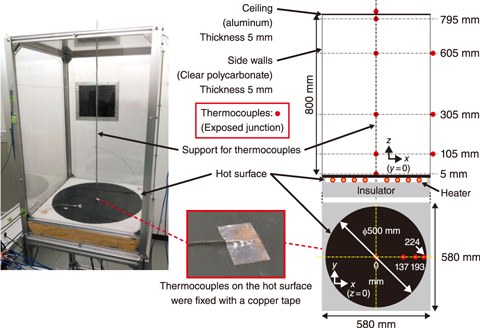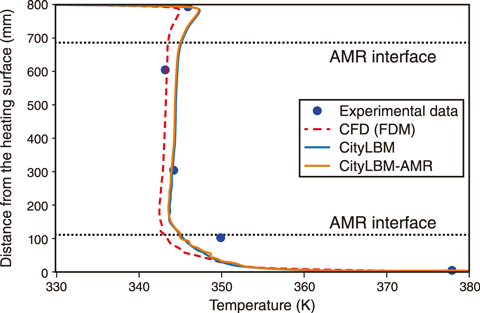
Fig.9-2 Experimental setup

Fig.9-3 Time-averaged air temperature
Thermal-hydrodynamics analyses based on detailed computational fluid dynamics (CFD) simulations are important for nuclear design and safety and are an essential tool for decommissioning the TEPCO’s Fukushima Daiichi Nuclear Power Station. It is necessary to perform multi-scale CFD simulations that resolves from fuel debris of mm-scale to the reactor pressure vessel of m-scale. The adaptive mesh refinement (AMR) method is a key technique to accelerate multi-scale simulations. In this work, therefore, an AMR version of the detailed CFD code named CityLBM was developed and applied to thermal-hydrodynamics problems.
CityLBM is based on the lattice Boltzmann method (LBM) and suitable for high-performance computing. In the conventional thermal-hydraulic model, both the velocity and temperature equations are formulated by LBM. However, this requires a large amount of computational memory, thus making it difficult to apply to large-scale problems. Using the finite difference method (FDM) for the temperature equation can reduce the memory usage to 1/7th that of the LBM during 3D analysis. Therefore, a hybrid CFD model that combines the FDM and LBM was proposed to reduce both memory usage and calculation time. Here, the effect of temperature on the LBM was evaluated as an external force term using the Boussinesq approximation, thus allowing a consistent formulation of the velocity and thermal flow fields.
CityLBM was then validated against using experimental data from a natural convection problem in a 3D system shown in Fig.9-2. Here, the bottom of the test vessel was equipped with a heat transfer surface. The Rayleigh number in the experiments was approximately 2 × 109. The data was obtained along the z-axis by taking the time average for 5 minutes. Although CityLBM showed slightly higher temperatures than did the the conventional FDM, both models reproduced the experiments within an error range of 10 K, as seen in Fig.9-3. Furthermore, when operating with 4 GPUs (NVIDIA® V100), CityLBM completed the calculations (total elapsed time) 6.7 times faster than did the conventional FDM with 36 CPUs (Intel Broadwell). CityLBM was thus concluded to be an efficient tool to simulate large-scale thermal convection problems that are required for decommissioning processes.
This study was supported by Joint Usage/Research Center for Interdisciplinary Large-scale Information Infrastructures (JHPCN) (jh180041-NAH, jh190049-NAH).
(Naoyuki Onodera)
<Previous: 9 Computational Science and E-Systems Research | Next: 9-2>